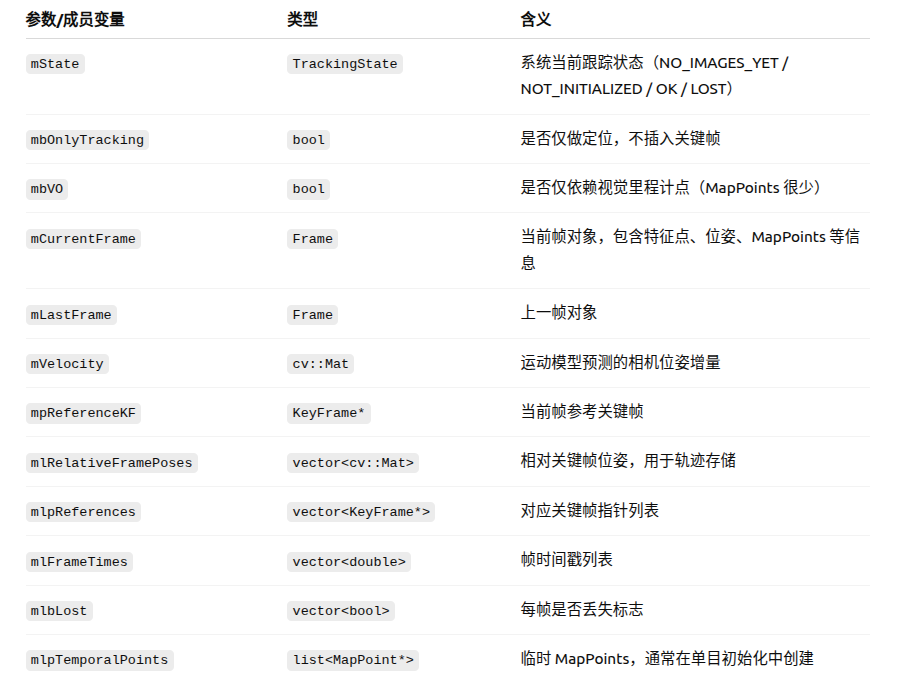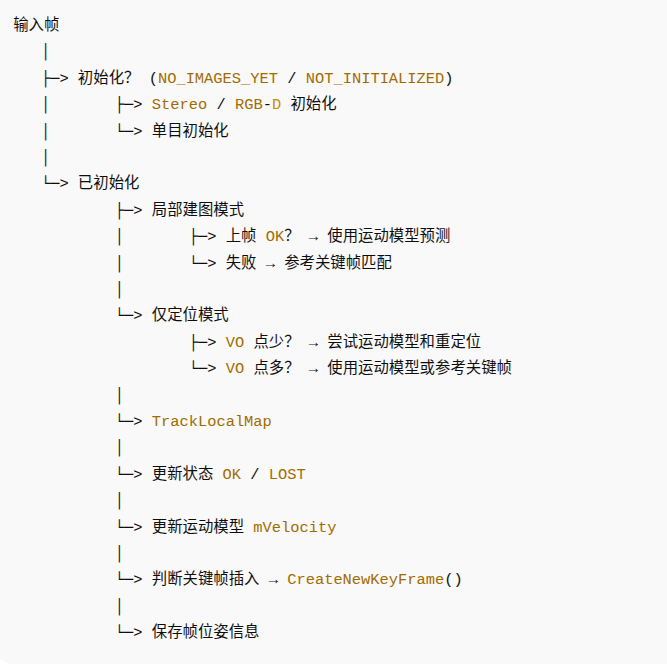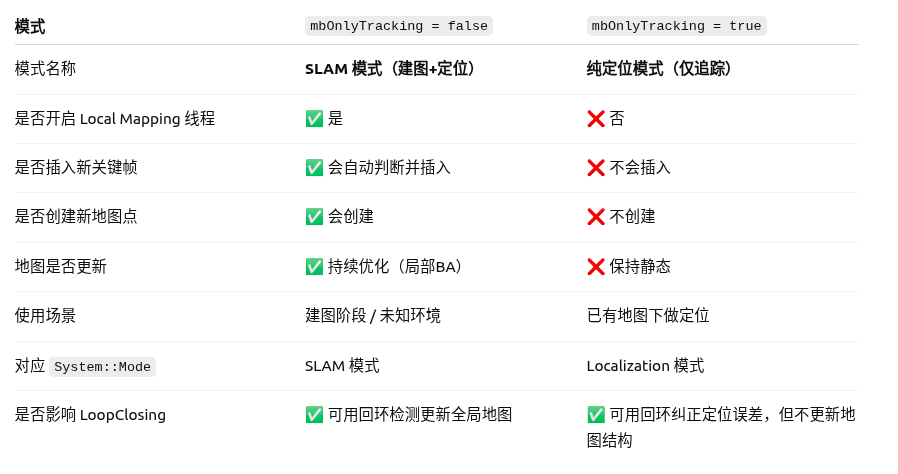目录
5.3.1 StereoInitialization() 函数
5.3.2 MonocularInitialization() 函数
5.4.1.2 CheckReplacedInLastFrame() 函数
5.4.1.3 TrackReferenceKeyFrame() 函数
5.4.1.4 TrackWithMotionModel() 函数
1 作用
(1)初始化检查与单目/双目/RGB-D初始化;
(2)利用运动模型或参考关键帧进行相机位姿估计;
(3)重定位处理(Tracking 丢失时);
(4)局部地图跟踪;
(5)关键帧插入判断与更新。
2 参数及含义
3 运行逻辑
4 代码
void Tracking::Track() { if(mState==NO_IMAGES_YET) { mState = NOT_INITIALIZED; } mLastProcessedState=mState; // Get Map Mutex -> Map cannot be changed unique_lock<mutex> lock(mpMap->mMutexMapUpdate); if(mState==NOT_INITIALIZED) { if(mSensor==System::STEREO || mSensor==System::RGBD) StereoInitialization(); else MonocularInitialization(); mpFrameDrawer->Update(this); if(mState!=OK) return; } else { // System is initialized. Track Frame. bool bOK; // Initial camera pose estimation using motion model or relocalization (if tracking is lost) if(!mbOnlyTracking) { // Local Mapping is activated. This is the normal behaviour, unless // you explicitly activate the "only tracking" mode. if(mState==OK) { // Local Mapping might have changed some MapPoints tracked in last frame CheckReplacedInLastFrame(); if(mVelocity.empty() || mCurrentFrame.mnId<mnLastRelocFrameId+2) { bOK = TrackReferenceKeyFrame(); } else { bOK = TrackWithMotionModel(); if(!bOK) bOK = TrackReferenceKeyFrame(); } } else { bOK = Relocalization(); } } else { // Localization Mode: Local Mapping is deactivated if(mState==LOST) { bOK = Relocalization(); } else { if(!mbVO) { // In last frame we tracked enough MapPoints in the map if(!mVelocity.empty()) { bOK = TrackWithMotionModel(); } else { bOK = TrackReferenceKeyFrame(); } } else { // In last frame we tracked mainly "visual odometry" points. // We compute two camera poses, one from motion model and one doing relocalization. // If relocalization is sucessfull we choose that solution, otherwise we retain // the "visual odometry" solution. bool bOKMM = false; bool bOKReloc = false; vector<MapPoint*> vpMPsMM; vector<bool> vbOutMM; cv::Mat TcwMM; if(!mVelocity.empty()) { bOKMM = TrackWithMotionModel(); vpMPsMM = mCurrentFrame.mvpMapPoints; vbOutMM = mCurrentFrame.mvbOutlier; TcwMM = mCurrentFrame.mTcw.clone(); } bOKReloc = Relocalization(); if(bOKMM && !bOKReloc) { mCurrentFrame.SetPose(TcwMM); mCurrentFrame.mvpMapPoints = vpMPsMM; mCurrentFrame.mvbOutlier = vbOutMM; if(mbVO) { for(int i =0; i<mCurrentFrame.N; i++) { if(mCurrentFrame.mvpMapPoints[i] && !mCurrentFrame.mvbOutlier[i]) { mCurrentFrame.mvpMapPoints[i]->IncreaseFound(); } } } } else if(bOKReloc) { mbVO = false; } bOK = bOKReloc || bOKMM; } } } mCurrentFrame.mpReferenceKF = mpReferenceKF; // If we have an initial estimation of the camera pose and matching. Track the local map. if(!mbOnlyTracking) { if(bOK) bOK = TrackLocalMap(); } else { // mbVO true means that there are few matches to MapPoints in the map. We cannot retrieve // a local map and therefore we do not perform TrackLocalMap(). Once the system relocalizes // the camera we will use the local map again. if(bOK && !mbVO) bOK = TrackLocalMap(); } if(bOK) mState = OK; else mState=LOST; // Update drawer mpFrameDrawer->Update(this); // If tracking were good, check if we insert a keyframe if(bOK) { // Update motion model if(!mLastFrame.mTcw.empty()) { cv::Mat LastTwc = cv::Mat::eye(4,4,CV_32F); mLastFrame.GetRotationInverse().copyTo(LastTwc.rowRange(0,3).colRange(0,3)); mLastFrame.GetCameraCenter().copyTo(LastTwc.rowRange(0,3).col(3)); mVelocity = mCurrentFrame.mTcw*LastTwc; } else mVelocity = cv::Mat(); mpMapDrawer->SetCurrentCameraPose(mCurrentFrame.mTcw); // Clean VO matches for(int i=0; i<mCurrentFrame.N; i++) { MapPoint* pMP = mCurrentFrame.mvpMapPoints[i]; if(pMP) if(pMP->Observations()<1) { mCurrentFrame.mvbOutlier[i] = false; mCurrentFrame.mvpMapPoints[i]=static_cast<MapPoint*>(NULL); } } // Delete temporal MapPoints for(list<MapPoint*>::iterator lit = mlpTemporalPoints.begin(), lend = mlpTemporalPoints.end(); lit!=lend; lit++) { MapPoint* pMP = *lit; delete pMP; } mlpTemporalPoints.clear(); // Check if we need to insert a new keyframe if(NeedNewKeyFrame()) CreateNewKeyFrame(); // We allow points with high innovation (considererd outliers by the Huber Function) // pass to the new keyframe, so that bundle adjustment will finally decide // if they are outliers or not. We don't want next frame to estimate its position // with those points so we discard them in the frame. for(int i=0; i<mCurrentFrame.N;i++) { if(mCurrentFrame.mvpMapPoints[i] && mCurrentFrame.mvbOutlier[i]) mCurrentFrame.mvpMapPoints[i]=static_cast<MapPoint*>(NULL); } } // Reset if the camera get lost soon after initialization if(mState==LOST) { if(mpMap->KeyFramesInMap()<=5) { cout << "Track lost soon after initialisation, reseting..." << endl; mpSystem->Reset(); return; } } if(!mCurrentFrame.mpReferenceKF) mCurrentFrame.mpReferenceKF = mpReferenceKF; mLastFrame = Frame(mCurrentFrame); } // Store frame pose information to retrieve the complete camera trajectory afterwards. if(!mCurrentFrame.mTcw.empty()) { cv::Mat Tcr = mCurrentFrame.mTcw*mCurrentFrame.mpReferenceKF->GetPoseInverse(); mlRelativeFramePoses.push_back(Tcr); mlpReferences.push_back(mpReferenceKF); mlFrameTimes.push_back(mCurrentFrame.mTimeStamp); mlbLost.push_back(mState==LOST); } else { // This can happen if tracking is lost mlRelativeFramePoses.push_back(mlRelativeFramePoses.back()); mlpReferences.push_back(mlpReferences.back()); mlFrameTimes.push_back(mlFrameTimes.back()); mlbLost.push_back(mState==LOST); } }
5 解析
5.1 初始化检查
if(mState==NO_IMAGES_YET) { mState = NOT_INITIALIZED; } mLastProcessedState=mState;
5.2 获取地图互斥锁
// Get Map Mutex -> Map cannot be changed unique_lock<mutex> lock(mpMap->mMutexMapUpdate);运行到这一步时地图点不可更新,等这一程序块运行结束自动解锁。
5.3 未初始化则初始化
if(mState==NOT_INITIALIZED) { if(mSensor==System::STEREO || mSensor==System::RGBD) StereoInitialization(); else MonocularInitialization(); mpFrameDrawer->Update(this); //退出当前帧 if(mState!=OK) return; }
5.3.1 StereoInitialization() 函数
详见:
https://blog.youkuaiyun.com/weixin_45728280/article/details/152281400?spm=1011.2415.3001.5331
5.3.2 MonocularInitialization() 函数
详见:
https://blog.youkuaiyun.com/weixin_45728280/article/details/152448072?spm=1011.2415.3001.5331
5.3.3 mState含义
5.4 已初始化则位姿跟踪
else { // System is initialized. Track Frame. bool bOK; // Initial camera pose estimation using motion model or relocalization (if tracking is lost) if(!mbOnlyTracking) { // Local Mapping is activated. This is the normal behaviour, unless // you explicitly activate the "only tracking" mode. if(mState==OK) { // Local Mapping might have changed some MapPoints tracked in last frame CheckReplacedInLastFrame(); if(mVelocity.empty() || mCurrentFrame.mnId<mnLastRelocFrameId+2) { bOK = TrackReferenceKeyFrame(); } else { bOK = TrackWithMotionModel(); if(!bOK) bOK = TrackReferenceKeyFrame(); } } else { bOK = Relocalization(); } } else { // Localization Mode: Local Mapping is deactivated if(mState==LOST) { bOK = Relocalization(); } else { if(!mbVO) { // In last frame we tracked enough MapPoints in the map if(!mVelocity.empty()) { bOK = TrackWithMotionModel(); } else { bOK = TrackReferenceKeyFrame(); } } else { // In last frame we tracked mainly "visual odometry" points. // We compute two camera poses, one from motion model and one doing relocalization. // If relocalization is sucessfull we choose that solution, otherwise we retain // the "visual odometry" solution. bool bOKMM = false; bool bOKReloc = false; vector<MapPoint*> vpMPsMM; vector<bool> vbOutMM; cv::Mat TcwMM; if(!mVelocity.empty()) { bOKMM = TrackWithMotionModel(); vpMPsMM = mCurrentFrame.mvpMapPoints; vbOutMM = mCurrentFrame.mvbOutlier; TcwMM = mCurrentFrame.mTcw.clone(); } bOKReloc = Relocalization(); if(bOKMM && !bOKReloc) { mCurrentFrame.SetPose(TcwMM); mCurrentFrame.mvpMapPoints = vpMPsMM; mCurrentFrame.mvbOutlier = vbOutMM; if(mbVO) { for(int i =0; i<mCurrentFrame.N; i++) { if(mCurrentFrame.mvpMapPoints[i] && !mCurrentFrame.mvbOutlier[i]) { mCurrentFrame.mvpMapPoints[i]->IncreaseFound(); } } } } else if(bOKReloc) { mbVO = false; } bOK = bOKReloc || bOKMM; } } }
5.4.1 运动模型+关键帧跟踪
if(!mbOnlyTracking) { // Local Mapping is activated. This is the normal behaviour, unless // you explicitly activate the "only tracking" mode. if(mState==OK) { // Local Mapping might have changed some MapPoints tracked in last frame CheckReplacedInLastFrame(); //如果运动模型为空或当前帧的ID小于重定位帧+2帧 if(mVelocity.empty() || mCurrentFrame.mnId<mnLastRelocFrameId+2) { //用参考关键帧估计当前相机位姿 bOK = TrackReferenceKeyFrame(); } else { bOK = TrackWithMotionModel(); if(!bOK) bOK = TrackReferenceKeyFrame(); } } else { bOK = Relocalization(); } }PS.正常SLAM模式(mState==OK)优先运动模型追踪,失败用关键帧匹配,彻底丢失就重定位。
5.4.1.1 mbOnlyTracking含义
5.4.1.2 CheckReplacedInLastFrame() 函数
(1)作用
Tracking线程每次处理新帧时,会先检查“上一帧”中使用的地图点是否被替换掉。
原因:
a.在LocalMapping(局部建图)线程中,可能进行了地图点融合,即两个相同位置的点被合并成一个新的MapPoint;
b.那么上一帧中引用的旧点就“过期”了;
c.Tracking需要更新引用,否则下一帧追踪就会错乱。
PS.地图点融合在局部建图线程中完成,此处不做过多介绍。
(2)声明:Tracking.h
void CheckReplacedInLastFrame();(3)定义:Tracking.cc
void Tracking::CheckReplacedInLastFrame() { for(int i =0; i<mLastFrame.N; i++) { MapPoint* pMP = mLastFrame.mvpMapPoints[i]; if(pMP) { //查询地图点是否被替换 MapPoint* pRep = pMP->GetReplaced(); if(pRep) { //更新为新的地图指帧 mLastFrame.mvpMapPoints[i] = pRep; } } } }
5.4.1.3 TrackReferenceKeyFrame() 函数
详见:
5.4.1.4 TrackWithMotionModel() 函数
详见:
https://blog.youkuaiyun.com/weixin_45728280/article/details/152604661?spm=1011.2415.3001.5331
5.4.1.5 Relocalization() 函数
详见:
5.4.2 仅定位
else { // Localization Mode: Local Mapping is deactivated if(mState==LOST) { bOK = Relocalization(); } else { if(!mbVO) { // In last frame we tracked enough MapPoints in the map if(!mVelocity.empty()) { bOK = TrackWithMotionModel(); } else { bOK = TrackReferenceKeyFrame(); } } else { // In last frame we tracked mainly "visual odometry" points. // We compute two camera poses, one from motion model and one doing relocalization. // If relocalization is sucessfull we choose that solution, otherwise we retain // the "visual odometry" solution. //是否成功通过运动模型追踪 bool bOKMM = false; //是否成功通过重定位(PnP + BoW)追踪 bool bOKReloc = false; //当前帧通过运动模型匹配到的 MapPoints vector<MapPoint*> vpMPsMM; //每个 MapPoint 是否被判定为外点 vector<bool> vbOutMM; //运动模型预测得到的相机位姿矩阵 cv::Mat TcwMM; //如果计算出了速度 if(!mVelocity.empty()) { bOKMM = TrackWithMotionModel(); vpMPsMM = mCurrentFrame.mvpMapPoints; vbOutMM = mCurrentFrame.mvbOutlier; TcwMM = mCurrentFrame.mTcw.clone(); } bOKReloc = Relocalization(); //运动模型有效,但重定位失败 if(bOKMM && !bOKReloc) { mCurrentFrame.SetPose(TcwMM); mCurrentFrame.mvpMapPoints = vpMPsMM; mCurrentFrame.mvbOutlier = vbOutMM; if(mbVO) { for(int i =0; i<mCurrentFrame.N; i++) { if(mCurrentFrame.mvpMapPoints[i] && !mCurrentFrame.mvbOutlier[i]) { //更新地图点被观测次数 mCurrentFrame.mvpMapPoints[i]->IncreaseFound(); } } } } else if(bOKReloc) { mbVO = false; } bOK = bOKReloc || bOKMM; } } }仅定位分三种情况:
(1)跟踪丢失(mState==LOST) → 尝试重定位;
(2)还在跟踪,且不是纯VO模式 →运动模型追踪,不行就用关键帧追踪;
(3)VO 模式(mbVO == true)。
5.5 局部地图跟踪
mCurrentFrame.mpReferenceKF = mpReferenceKF; // If we have an initial estimation of the camera pose and matching. Track the local map. if(!mbOnlyTracking) { if(bOK) bOK = TrackLocalMap(); } else { // mbVO true means that there are few matches to MapPoints in the map. We cannot retrieve // a local map and therefore we do not perform TrackLocalMap(). Once the system relocalizes // the camera we will use the local map again. if(bOK && !mbVO) bOK = TrackLocalMap(); }
5.5.1 TrackLocalMap() 函数
详见:
5.6 状态更新与关键帧管理
if(bOK) mState = OK; else mState=LOST; // Update drawer mpFrameDrawer->Update(this); // If tracking were good, check if we insert a keyframe if(bOK) { // Update motion model if(!mLastFrame.mTcw.empty()) { cv::Mat LastTwc = cv::Mat::eye(4,4,CV_32F); mLastFrame.GetRotationInverse().copyTo(LastTwc.rowRange(0,3).colRange(0,3)); mLastFrame.GetCameraCenter().copyTo(LastTwc.rowRange(0,3).col(3)); mVelocity = mCurrentFrame.mTcw*LastTwc; } else mVelocity = cv::Mat(); mpMapDrawer->SetCurrentCameraPose(mCurrentFrame.mTcw); // Clean VO matches for(int i=0; i<mCurrentFrame.N; i++) { MapPoint* pMP = mCurrentFrame.mvpMapPoints[i]; if(pMP) if(pMP->Observations()<1) { mCurrentFrame.mvbOutlier[i] = false; mCurrentFrame.mvpMapPoints[i]=static_cast<MapPoint*>(NULL); } } // Delete temporal MapPoints for(list<MapPoint*>::iterator lit = mlpTemporalPoints.begin(), lend = mlpTemporalPoints.end(); lit!=lend; lit++) { MapPoint* pMP = *lit; delete pMP; } mlpTemporalPoints.clear(); // Check if we need to insert a new keyframe if(NeedNewKeyFrame()) CreateNewKeyFrame(); // We allow points with high innovation (considererd outliers by the Huber Function) // pass to the new keyframe, so that bundle adjustment will finally decide // if they are outliers or not. We don't want next frame to estimate its position // with those points so we discard them in the frame. for(int i=0; i<mCurrentFrame.N;i++) { if(mCurrentFrame.mvpMapPoints[i] && mCurrentFrame.mvbOutlier[i]) mCurrentFrame.mvpMapPoints[i]=static_cast<MapPoint*>(NULL); } }
5.6.1 更新运动模型
// Update motion model if(!mLastFrame.mTcw.empty()) { cv::Mat LastTwc = cv::Mat::eye(4,4,CV_32F); //上一帧旋转矩阵的逆Rwc放入LastTwc mLastFrame.GetRotationInverse().copyTo(LastTwc.rowRange(0,3).colRange(0,3)); mLastFrame.GetCameraCenter().copyTo(LastTwc.rowRange(0,3).col(3)); //当前帧相机速度模型 mVelocity = mCurrentFrame.mTcw*LastTwc; } else //如果上一帧没有有效位姿,则运动模型清空 mVelocity = cv::Mat();
5.6.2 清理 VO 匹配点和临时 MapPoints
mpMapDrawer->SetCurrentCameraPose(mCurrentFrame.mTcw); // Clean VO matches for(int i=0; i<mCurrentFrame.N; i++) { MapPoint* pMP = mCurrentFrame.mvpMapPoints[i]; if(pMP) if(pMP->Observations()<1) { mCurrentFrame.mvbOutlier[i] = false; mCurrentFrame.mvpMapPoints[i]=static_cast<MapPoint*>(NULL); } } // Delete temporal MapPoints for(list<MapPoint*>::iterator lit = mlpTemporalPoints.begin(), lend = mlpTemporalPoints.end(); lit!=lend; lit++) { MapPoint* pMP = *lit; delete pMP; } mlpTemporalPoints.clear();
5.6.3 判断是否插入关键帧
// Check if we need to insert a new keyframe if(NeedNewKeyFrame()) CreateNewKeyFrame();
5.6.3.1 NeedNewKeyFrame() 函数
详见1:
https://blog.youkuaiyun.com/weixin_45728280/article/details/152323101?spm=1011.2415.3001.5331
5.6.3.2 CreateNewKeyFrame() 函数
详见2:
5.6.4 删除当前帧中异常MapPoints
// We allow points with high innovation (considererd outliers by the Huber Function) // pass to the new keyframe, so that bundle adjustment will finally decide // if they are outliers or not. We don't want next frame to estimate its position // with those points so we discard them in the frame. for(int i=0; i<mCurrentFrame.N;i++) { if(mCurrentFrame.mvpMapPoints[i] && mCurrentFrame.mvbOutlier[i]) mCurrentFrame.mvpMapPoints[i]=static_cast<MapPoint*>(NULL); }清除外点。
5.7 跟踪丢失
// Reset if the camera get lost soon after initialization if(mState==LOST) { //如果全局地图中关键帧<=5 if(mpMap->KeyFramesInMap()<=5) { cout << "Track lost soon after initialisation, reseting..." << endl; //重启SLAM,清空地图、清空关键帧数据库、重置跟踪器状态 mpSystem->Reset(); return; } } if(!mCurrentFrame.mpReferenceKF) mCurrentFrame.mpReferenceKF = mpReferenceKF; mLastFrame = Frame(mCurrentFrame);
5.8 记录帧位置信息
// Store frame pose information to retrieve the complete camera trajectory afterwards. if(!mCurrentFrame.mTcw.empty()) { //当前帧相对于参考关键帧的相对位姿 = 当前帧的世界位姿(世界 → 当前帧)*参考关键帧的逆变换 cv::Mat Tcr = mCurrentFrame.mTcw*mCurrentFrame.mpReferenceKF->GetPoseInverse(); //当前帧相对参考关键帧的位姿矩阵 mlRelativeFramePoses.push_back(Tcr); //当前帧对应的参考关键帧指针 mlpReferences.push_back(mpReferenceKF); //当前帧的时间戳 mlFrameTimes.push_back(mCurrentFrame.mTimeStamp); //当前帧是否 tracking 丢失 mlbLost.push_back(mState==LOST); } else { // This can happen if tracking is lost //当前帧跟踪失败就复制上一帧的位姿、参考关键帧、时间戳 mlRelativeFramePoses.push_back(mlRelativeFramePoses.back()); mlpReferences.push_back(mlpReferences.back()); mlFrameTimes.push_back(mlFrameTimes.back()); mlbLost.push_back(mState==LOST); }

























 1367
1367

 被折叠的 条评论
为什么被折叠?
被折叠的 条评论
为什么被折叠?








